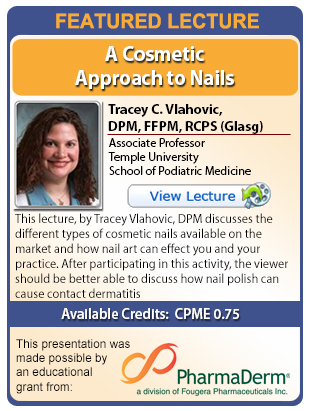|
Nail Lacquer History
Nail polish or nail enamel/lacquer began as a product of the automobile industry1. In the 1920s, lacquer technology was under development to replace slow-drying oil-based automotive paints. Charles Revson, the founder of Revlon cosmetics, was the first to add pigmentation to clear lacquer to create opaque nail polish in 19302. Thus, nail polish, or the applying of pigmented lacquer to the nail plate, was born. The ingredients for nail polish have changed minimally since its debut; typically it consists of “pigments suspended in a volatile solvent to which film formers have been added.”2 One of the primary film formers employed is nitrocellulose, which creates a film that adheres to the nail plate and allows for oxygen permeability, ultimately creating an inactive and non-damaging coating on the nail plate. In addition to a compound that will create a shiny, tough surface, a secondary film forming resin must be added for flexibility, or the polish would crack. This resin was toluene sulfonamide formaldehyde, but this compound is highly allergenic and has since been removed from many polishes, especially those labeled hypo-allergenic. It has been replaced with other resins that cause the polish to be more brittle and still can cause an allergenic response. After these two ingredients, nail polish further consists of plasticizers (to keep the product flowing in the bottle), solvents, colorants and specialty filters (to create various specialized effects on the nails).

Layers and Layers
Typically, home nail polish application consists of three layers:
-
A base coat, which is generally clear and helps the pigmented polish to adhere and to prevent chipping of nail polish.
-
Nail polish, which camouflages the underlying nail plate.
-
A top coat, which is also clear, leaves a shiny finish, and provides further protection against chipping.
Acrylic Nail Extensions
“Acrylic” nails or nail extensions can come either as a preformed piece of plastic that is glued to the nail plate or as a custom-made, “sculptured” acrylic extension to the natural nail2. As with the other nail cosmetics discussed, an issue with acrylic nails is allergic contact dermatitis, especially to the acrylate glues. Beyond a skin reaction due to the glue, it has been reported that an acrylate allergy that was induced by acrylic nails resulted in a knee replacement implant failure3. The acrylic bone cement often used in these procedures can cross-react to the polymers used in nail cosmetics. It is important to get a thorough history and patch testing if a patient is a candidate for an orthopedic implant and has a history of fingernail or toenail sensitivity to a nail cosmetic.
Light Cured Gel Polish
A trend that was launched on the market as Light Cured Nails (LCN) in 1985 by Wilde Cosmetics has become the industry standard due to their long wearing capability (2-4 weeks) and chip/dent/scratch resistant shiny finish4. There are now 46 brands of this gel-polish which typically consist of ethyl cyanoacrylate and polymethyl-methacrylate monomers that are cured with either UV or LED devices4. Other names associated with Gel nails are: Shellac, Gellish, Gelac, etc4. The procedure for applying a gel prosthesis to the nail is as follows: a primer solution is applied to allow the gel layer to adhere to the nail plate. Next, the gel polish is applied to the entire nail plate while avoiding the cuticle. It is then cured under a UV light for about two minutes. A cleaning solution is applied to the finalized gel nail to remove any excess gel or residue after the curing process.
Gel nails have not only become popular in their durability, but also for those who have nail dystrophy and wanted a different option than acrylic nails or nail enamel to camouflage the nail. Also, musicians who play string instruments or athletes who traumatize their feet daily have both looked to gel nails as an option for cosmesis and protection.
Polish is Compatible with Current Topical Prescription Nail Antifungals
Previously, topical antifungal medications could not be used concurrently with nail polish. Recently, the application of nail polish with tavaborole 5% solution and efinaconazole 10% solution were investigated on cadaver fingernails. Although nail polish does not appear to influence efinaconazole penetration into the nail through two coats of nail polish, it can become tacky with repeated application5. Up to four layers of nail polish does not seem to inhibit penetration of tavaborole either6. In neither case has the impact of nail polish on efficacy been assessed, nor is it contraindicated.
Best wishes,
Tracey C. Vlahovic, DPM, FFPM, RCPS (Glasg)
[email protected]
References:
-
Draelos ZD. Nail Cosmetic Issue. Dermatol Clin. 2000;18:675-683.
-
Draelos ZD. Cosmetic Treatment of Nails. Clinics Derm. 2013;31:573-577.
-
Haughton AM and Belsito DV. Acylate allergy induced by acrylic nails resulting in prosthesis failure. JAAD. 2008;59(5):S123-124.
-
Nanda S and Grover C. Utility of Gel Nails in Improving the Appearance of Cosmetically Disfigured Nails: Experience with 25 Cases. J Cutan Aesthet Surg. 2014;7(1):26-31.
-
Zeichner JA, Stein Gold L, Korotzer A. Penetration of (14C)-Efinaconazole Solution does Not Appear to be Influenced by Nail Polish. J Clin Aesthet Dermatol. 2014;7(9):45-48.
-
Vlahovic T, Merchant T, Chanda S, et al. In Vitro Nail Penetration of Tavaborole Topical Solution, 5%, Through Nail Polish on Ex Vivo Human Fingernails. J Drugs Dermatol 2015;14(7):675-678.
### |
